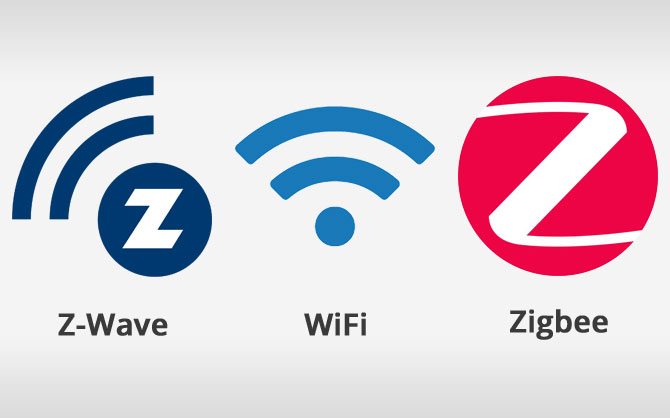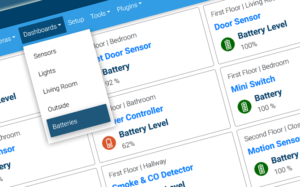Which Technology Is Best?
Z-Wave, Zigbee and WiFi are the leading wireless smart home technologies but they are not compatible with each other. While it’s possible to build a smart home system based entirely on just one of these, a better and more flexible approach is pick the products that best suit your needs and then link them together with a multi-tech hub (like a HomeTroller). In this article, we’ll take a look at the similarities and differences of each technology so you can make the most informed choices.
Z-Wave
This technology was developed in the early 2000s by the Danish company Zensys. It’s a low power mesh network technology that operates on the 800-900 MHz band. Line of sight range is often specified in excess of 100′ but walls, floors, ceilings, appliances and furniture will tend to reduce that significantly. Even so, line powered Z-Wave smart products function as repeaters and that generally overcomes any individual device range issues.
Products
Z-Wave is used in a wide range of smart home devices. It’s low power consumption allows it to be used in a variety of battery-powered devices too. Here are some of the more popular product categories:
- Light Switches
- Bulbs
- Plug-in Switches
- Thermostats
- Sensors
- Remote Controls
- Door Locks
- Garage Door Controllers
- Water Valves
Hub Compatibility
Z-Wave is supported in the widest range of the most popular multi-tech hubs including HomeSeer, SmartThings, Hubitat, Vera and more. It’s also supported by a number of smart home software programs including HomeSeer, Indigo and programs that use OpenZWave. Note that Z-Wave is not supported (directly) by Amazon or Google smart speakers. However, smart speakers can control Z-Wave devices with the addition of a multi-tech hub.
Interoperability
Since the inception of Z-Wave, all products have undergone an interoperability certification procedure. The goal of this process has been to ensure product compatibility throughout the entire Z-Wave ecosystem and it’s been largely very successful. Widespread interoperability played a very significant role in helping Z-Wave achieve the highest rate of industry adoption. At this writing, there are more than 3,000 Z-Wave certified products worldwide.
That said, it’s worth noting that in the early years, the certification process wasn’t perfect and it wasn’t enforced consistently from product to product. While those problems have largely been ironed out, the biggest challenge going forward lies with the hub makers. As the technology itself continues to evolve, it’s essential for hub makers to keep pace by adding the latest features.
Availability
Z-Wave products communicate over region-specific frequencies that are regulated by governments. In the US, products use 908 MHz. In Europe, it’s 868 MHz. There are around a dozen different frequencies used throughout the world. There are some companies that manufacture Z-Wave products for all or most of these regions. However, many manufacturers limit their inventories to the US and/or Europe.
Recommended For...
If you’re in the US or Canada and you want to keep things simple, Z-Wave offers the widest selection of choices for virtually every product category. Brands include HomeSeer, GE, Honeywell, Leviton, GoControl, Fibaro, Aeotec and many others.
If you’re outside of the US, your choices will be a bit more limited. Look for brands like Aeotec, Fibaro, Qubino and others.
You will need a Z-Wave compatible hub or software program to monitor and control these devices but there are plenty of options available.
Zigbee
This technology was developed and standardized by the Zigbee Alliance in 2003. Like Z-Wave, it is also a low power ‘mesh network’ technology. However, most devices operate on the much higher 2.4 GHz band. As with Z-Wave, line of sight range is often specified in excess of 100′ but walls, floors, ceilings, appliances and furniture will tend to reduce that significantly. Even so, line powered Zigbee smart products function as repeaters and that generally overcomes any hub to product range issues.
Products
Zigbee has flourished in the commercial automation space but has been slower to ramp in the consumer smart home market. As with Z-Wave, its low power consumption allows it to be used in a variety of battery-powered devices too. Here are some of the more popular applications:
- Bulbs (Lots of them!)
- Sensors
- Plug-in Switches
- Remote Controls
- Door Locks
Hub Compatibility
Zigbee is supported by a wide range of the most popular multi-tech hubs including HomeSeer, SmartThings, Wink, Hubitat, Vera and more. It’s also supported by a number of smart home software programs including HomeSeer and a number of open source programs. Amazon’s Echo Plus is the only smart speaker to support Zigbee devices directly. Other smart speakers can control Zigbee devices with the addition of a multi-tech hub.
Interoperability
The biggest challenge for industry-wide adoption of Zigbee in the early years was its failure to enforce any interoperability standard. This lead to a very fractured ecosystem of incompatible devices. The issue was eventually addressed with the implementation of the Zigbee Pro standard back in 2007 but it was still an ‘opt in’ choice for manufacturers. Since then, there has been a slow but steady increase of interoperable Zigbee devices. The latest Zigbee 3.0 products exhibit very good interoperability.
Availability
Since Zigbee operates on the universally-accepted 2.4 GHz band, the same chip may be used in products distributed around the world. This greatly reduces the manufacturing logistics required to create Zigbee products for the world market. For the most part, Zigbee devices have come from Europe & Asia. US manufacturers have been slow to add Zigbee products to their smart home catalogs.
Recommended For...
Zigbee devices tend to be less expensive than their Z-Wave counterparts and that alone has made them a popular choice. A number of hub makers have also released their own brand of Zigbee powered sensors including SmartThings, Wink, IRIS and IKEA.
You will need a Zigbee compatible hub or software program to monitor and control these devices but there are plenty of options available. Amazon’s Echo Plus is the only smart speaker with a built-in Zigbee radio.
WiFi
WiFi is a 2.4 GHz network communication standard that’s been adapted to work with smart home devices. Unlike Z-Wave and Zigbee, it is not a mesh network technology so smart devices don’t repeat signals and each device must be within direct range of the router to work. It makes sense to invest in a high quality router or router mesh system for the best performance.
Note that WiFi is also a power hungry technology. Battery operated devices, particularly small ones, have a much lower battery life than comparable Z-Wave or Zigbee devices.
Products
WiFi works with a wide range of smart home devices. Popular products include…
- Light Switches
- Bulbs
- Thermostats
- Plug-in Switches
- AV Controllers
- Irrigation Controllers
- Sensors
- Door Locks
- Garage Door Controllers
Hub Compatibility
WiFi is the only technology that’s supported by all three smart speaker platforms from Amazon, Google and Apple. As such, it does not require a multi-tech hub unless for simple voice control. However, adding a multi-tech hub will provide more flexible and powerful automation features.
WiFi product integrations are supported by virtually all multi-tech hubs including HomeSeer, SmartThings, Wink, Hubitat, Vera and more. It’s also supported by a number of smart home software programs including HomeSeer, Indigo and a number of open source programs.
Interoperability
The landscape of WiFi smart home devices is comprised of multiple ecosystems. One company, Tuya, powers thousands of products on their IoT platform. However, the bulk of the remainder are made up of company-specific integrations. Each of these is based on a different integration API and for the most part, they do not work together. Many companies do provide their own integrations with Amazon or Google smart speakers and HomeKit compatible ones will also work with Apple smart speakers and products.
Availability
WiFi operates on the universally-accepted 2.4 GHz band and works through your home’s router. Products are widely available.
Recommended For...
If you’re looking to tip-toe into the smart home world, WiFi is the simplest and least expensive way to do it. It’s the only technology that does not require a hub. Just install the device, download the app and off you go! Bear in mind that automations will be limited to simple scheduled on/off operations. Voice control can be added easily with the addition of a smart speaker and more advanced automation can be accomplished with the addition of a multi-tech hub or software program.









21 thoughts on “Z-Wave vs Zigbee vs WiFi | Which Is Best For Your Home?”
How about integration with Insteon?
Yes, we’ve offered a plugin for Insteon integration for a very long time.
Did I miss something? It surprised me that the Zigbee assessment omitted what appears to be it’s greatest deficiency for HomeSeer users. HomeSeer does not directly support Zigbee, but requires an intermediary device, the Osram Lightify hub. Osram has announced shutdown of their servers (in about a year if I recall correctly). Even while Osram still operates their servers this arrangement renders HomeSeer Zigbee devices internet-dependent, a major flaw for a home auto system which differentiates itself as being internet-aware, not internet-dependent. With Zigbee, that just is not the case. Unless the as yet unreleased new HomeSeer software internalizes Zigbee support, a subject which I don’t recall seeing addressed, then the Zigbee devices I’ve already upgraded to Z-Wave+ will be joined by all those remaining.
Steven – Thanks for writing. Yes, we added local Zigbee support to HS4 (currently in beta). We’re also reselling the Nortek HUSBZB-1 interface which includes built-in Zigbee and Z-Wave radios: https://shop.homeseer.com/collections/z-wave-usb-sticks-network-controllers/products/nortek-usb-zigbee-zwave-interface
I’ve used HomeSeer since the 90’s but I continue to be disappointed with the ongoing apparent disdain for anything Insteon and it bugs me that you seem to go out of your way to totally ignore this technology. I agree completely with Dave and Krufka. Z-wave has been nothing but an unreliable pain for me and I have now totally eliminated all ZW devices from my system. And wifi can be subject to exactly the issues Dave mentioned. So… I don’t know what the beef is with Insteon, but I wish it would go away. If you are not going to be objective, what exactly is that saying about HomeSeer?
Thanks,
Dale
Dale – I’ve limited the article to the the 3 most popular wireless technologies. Most modern hubs have built in support for Z-Wave, Zigbee and WiFi so it made sense to highlight them. Note that we did not include Lutron or Bluetooth wireless technologies either for the same reasons.
I had used Home Seer on a dedicated PC to run an extensive X10 system for decades (which worked flawlessly BTW). I was recently forced to renovate my home and decided to make a change. I purchased the Zee S2 and replaced all of my legacy X-10 wall switches with Leviton Z-wave switches, and I also still have all of my legacy X-10 lamp and appliance modules controlled by the S2 as well. Love the fact that by using the S2 I was able to upgrade to Z-Wave while till using all of my legacy Z-10 Modules.
Great products.
Steve – glad our Zee is working well for you. Thanks for the good word! 👍
It should be worth mentioning Bluetooth Smart.
– It’s common with HomeKit devices.
– Does not require a cloud service like many WiFi devices.
– It does support repeaters.
– Can be controlled directly from phones.
I remember seeing Kwikset Bluetooth locks hit the market some years ago but haven’t seen a lot of other smart home devices. I do see quite a few smart bulbs on Amazon. Yes, agreed… worth a mention. I don’t think there’s quite enough mind-share to add it to the top three though, at least not yet.
Wifi is best for me as it integrate with most devices and it’s easy to manage as I have close to 60 devices online, including the garage and the green house.
Just set them up on the guest wifi so they are separate to your home lan for security reason!
Norm – yes, a guest WiFi network is definitely a good idea. I went a little further and installed a second router for my smart devices since some of them are Ethernet connected too. That said, 60 WiFi smart devices is definitely a lot. I’m guessing you have a better than average router to keep up with the traffic.
Something worth noting that specific to WIFI: many WIFI-based home automation products need to make an internet hop out to the manufacturers server and then back to your home. Most of the time this happens within milliseconds without issue. However, if your ISP is down, your WIFI-based automation may also be down. Further, if the manufacturer ever shuts down their servers you may lose the ability to control your devices (this may be a temporary outage in the event their server falls over, or, it could be permanent (if they go out of business). This is NOT the case with Z-wave and ZigBee as all the control happens within your hub/controller. Hence, I would be reluctant to rely on WIFI for all of your automation needs.
Dave – Thanks for mentioning that. It’s a good point which I didn’t really address. Tuya integration normally works this way. However, our integration will control Tuya devices locally after they’ve been added with the Tuya app. Anyway, thanks for the heads up… might be worth a little revision!
I am using all of them but to me z-wave performance is the worst. I have roller shades opening and closing at sunrise/sunset and every day there is one, two or three windows that would miss the event. It never happened with Insteon or hue lights. I’m very disappointed with z-wave 😤
Thanks for taking a moment to comment. My experience is the reverse. in my case, Z-Wave is rock solid My situation is the opposite. I have 40 Z-Wave devices in my network and they are all rock solid… no issues. However, I’m using a HomeSeer hub (S6 PRO), a Z-NET Z-Wave interface, and all of my devices are Z-Wave Plus (GEN5). Before Z-Wave Plus came out, things were not as solid!
I’ve done hundreds of ZWave installations over the past 20 years and it simply works. If it’s not working, there is a logical reason why it’s not working. I suspect the hub may be the culprit barring any radio distance/obstruction issues. Some hubs have features such as polling, automatic network rediscovery, and self healing of the routing table, etc. Some hubs do not have these features, especially first generation hubs. Also, just like any radio device, sometimes they go bad and the radio signal degenerates. Hire a professional who knows how to diagnose these types of problems or purchase a diagnostic tool that measures signal strength.
I still have a lot of Insteon products, and as switches have blown (sigh) I’ve replaced with the newer ones with mesh. I need something that will control all of it. What do you recommend, sounds like z-wave isn’t it?
If you wan to continue to use Insteon and also start adding Z-Wave, you’ll need one of our HomeTrollers or a similar multi-tech hub.
If you don’t have a HomeTroller and run on a standard PC, what interface does HST support using Insteon?
George – I know that Mark Sandler’s Insteon plugin supports the Smarthome 2413U interface, so that’s a safe bet. You should check out his forum for details: https://forums.homeseer.com/forum/lighting-primary-technology-plug-ins/lighting-primary-technology-discussion/insteon-mnsandler
Comments are closed.